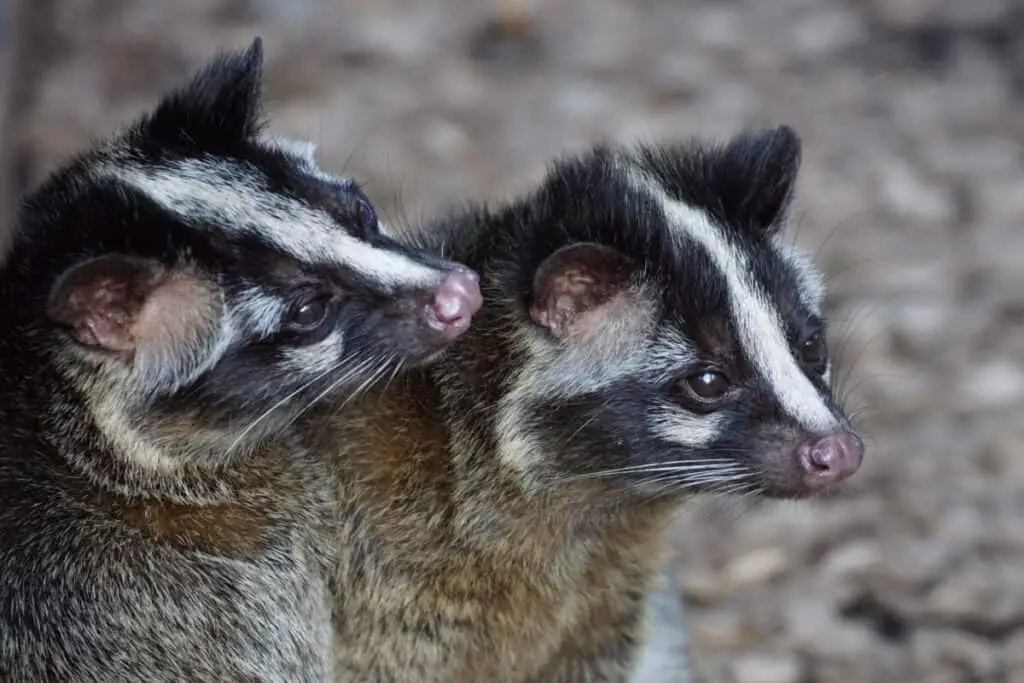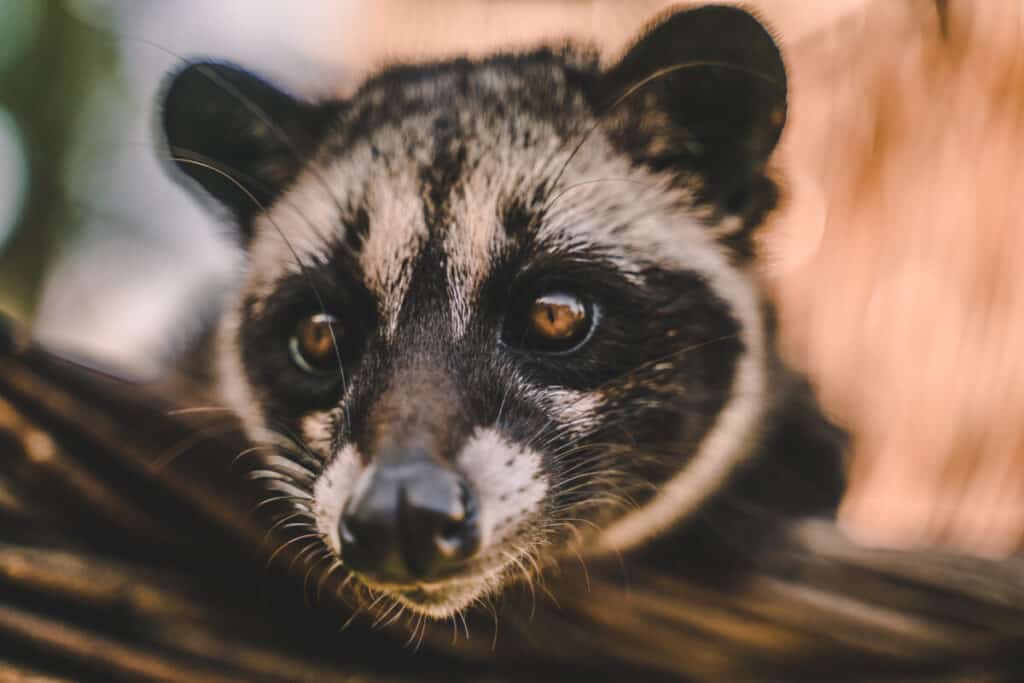The Masked Palm Civet (Paguma larvata) is a small, nocturnal mammal that belongs to the Viverridae family. It is commonly found in Southeast Asia and China, inhabiting forests, shrublands, and plantations. This species is known for its distinctive appearance – with dark brown fur on its back and white fur around its eyes, resembling a mask.
Despite being classified as Least Concern by the International Union for Conservation of Nature (IUCN), the population of Masked Palm Civets has been significantly impacted due to hunting and habitat destruction. There are also concerns regarding their role as potential carriers of zoonotic diseases such as SARS-CoV-2, which have led to increased interest in studying their behavior and ecology.
In this article, we will explore various aspects of the Masked Palm Civet’s biology including its morphological features, distribution range, habitat requirements, diet preferences, reproduction behaviors, conservation status, and significance in public health issues.

Morphological Features And Physical Characteristics
The masked palm civet is a small, nocturnal mammal that belongs to the Viverridae family. It has a distinctively pointed snout and long whiskers, which help it navigate through its environment at night. The fur on its body is typically grayish-brown in color with black stripes running along its back and sides. Its tail is about half the length of its body and covered with short, coarse hair.
Behavioral traits of the masked palm civet include being solitary animals that are primarily active at night. They have been observed climbing trees in search of food such as fruits, insects, small mammals, and birds. In addition to their diet, they mark their territory with urine and feces like many other members of the Viverridae family.
The evolutionary history of the masked palm civet can be traced back to around 20 million years ago when viverrids first appeared in Asia. Over time, these animals adapted to various environments across the continent resulting in numerous species with different physical characteristics and behaviors. Today, there are over 30 living species within this family including the masked palm civet which continues to thrive despite habitat loss due to deforestation and hunting for bushmeat consumption.
Family Viverridae: Exploring the Fascinating Realm of Civets
Distribution And Habitat Range
Morphological features and physical characteristics of the masked palm civet are vital factors in determining its ecological impact. These small mammals have a distinct appearance, with their black fur and white stripes on the face and tail. They also possess sharp claws and teeth that enable them to climb trees easily. The size of an adult male ranges from 45-71 cm long, including its bushy tail which is about one-third of its body length.
The distribution range of masked palm civets includes Southern China, Southeast Asia, Indonesia, and some parts of India. However, populations have declined significantly due to habitat loss caused by deforestation for agriculture expansion and urbanization.
As a result, these animals are now considered an endangered species under IUCN’s Red List category. Despite their small size, they play an important role in maintaining forest ecosystems through seed dispersal and insect control. Therefore, conservation efforts must be made to protect this unique mammalian species from extinction.
Civet Chronicles: Unveiling the Mysterious Lifecycle of Civets!
Diet And Feeding Habits
Feeding preferences of masked palm civets vary depending on their geographic location. In general, they are omnivores and feed on a variety of foods including fruits, insects, small vertebrates like birds and rodents, and occasionally carrion. They have been observed to consume the fruit of various plant species such as figs, mangoes, guavas, and papayas. The availability of food sources seems to play a significant role in determining their diet.
Dietary adaptations can be seen in masked palm civets living in urban areas where they have adapted to consuming human-associated food resources such as garbage and pet food. Studies suggest that this adaptation has led to an increase in population density in these areas due to the abundance of food available year-round.
However, this dietary shift may also lead to negative consequences for both the animals themselves and humans since it brings them closer together and increases the risk of disease transmission between them. Further research is necessary to fully understand how masked palm civets’ feeding habits affect their ecology and interactions with other organisms within their respective ecosystems.
Civets’ Predators Exposed: Unveiling the Threats
Reproduction And Breeding Behaviors
Breeding season for masked palm civets varies depending on their geographical location. In Southeast Asia, the breeding season typically begins in February and lasts until June, while in China it starts as early as September and ends in December.
During this time, males become more territorial and engage in mating rituals to attract females. Mating rituals of masked palm civets involve various behaviors such as scent marking, vocalizations, chasing, and physical displays.
Males will often mark their territory by rubbing secretions from glands located on their cheeks onto trees or other objects within their range. They also emit a high-pitched call to signal their presence to potential mates.
Once a female is present, the male will chase her down before engaging in copulation. The gestation period for these animals lasts around 50 days before females give birth to litters of one to four offspring.
Conservation Status And Threats
The masked palm civet is currently listed as a species of ‘Least Concern’ on the International Union for Conservation of Nature (IUCN) Red List. However, this does not mean that they are completely free from threats and challenges to their survival.
Habitat loss remains one of the biggest issues faced by this species. As forests are cleared for human settlements, agriculture, and industrial activities, these animals lose their natural habitat and struggle to find suitable places to live.
Apart from habitat loss, hunting pressure also poses a significant threat to the masked palm civet’s population. They have been hunted for both meat consumption and traditional medicine in some parts of Asia. Although there are legal measures in place to regulate such activities, poaching still occurs in many areas due to inadequate enforcement or limited resources.
The conservation efforts aimed at preserving this species should focus on addressing these two main threats – habitat loss and hunting pressure – through effective policies and actions that promote sustainable land use practices and law enforcement mechanisms that reduce illegal hunting practices.
Significance In Public Health Issues
The conservation status and threats facing the masked palm civet are significant concerns that require attention. While there is limited information on population numbers, habitat loss due to deforestation, hunting for bushmeat, and capture for the pet trade have contributed to declining populations in some areas.
Additionally, as a nocturnal animal with elusive behavior, it can be challenging to study and monitor masked palm civets effectively.
However, aside from its ecological importance, this species has also gained notoriety due to zoonotic transmission of diseases such as SARS-CoV-2. Studies suggest that the virus may have originated from bats but was transmitted through an intermediate host – possibly the masked palm civet – before infecting humans. As these animals are sold in wildlife markets across Asia and parts of Africa as exotic pets or consumed for their meat, they pose a risk for disease outbreaks.
It is therefore essential to implement effective disease control strategies while balancing conservation efforts to mitigate potential health risks associated with human-wildlife interactions.
Zoonotic transmission and emerging infectious diseases continue to be a global threat, highlighting the need for integrated approaches towards wildlife management and public health policies. In light of recent pandemics like COVID-19, understanding the role of wildlife hosts in transmitting diseases is critical in preventing future outbreaks.
The significance of studying lesser-known species like the masked palm civet lies not only in conserving biodiversity but also in identifying potential sources of zoonotic pathogens. By prioritizing research on these animals’ ecology and behavior alongside implementing sustainable conservation measures and responsible trading practices, we can reduce our vulnerability to these kinds of threats while safeguarding natural resources for generations to come.

Conclusion
The masked palm civet, a small mammal native to Southeast Asia, boasts distinct physical features and a unique diet.
Its ability to adapt to various habitats has allowed it to thrive in both natural and human-altered environments.
Despite this resilience, the species faces several threats due to habitat loss and hunting for its meat and fur.
In addition to being an important part of local ecosystems, the masked palm civet also plays a role in public health issues as a potential carrier of diseases such as SARS-CoV-2.
As humans continue to encroach on their habitat, it is crucial that conservation efforts are put in place to protect this species and prevent further transmission of zoonotic diseases.
The masked palm civet serves as a reminder of the interconnectedness between animal and human health, highlighting the importance of preserving biodiversity for our own well-being.
